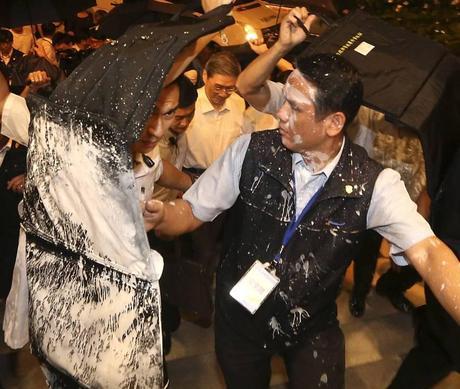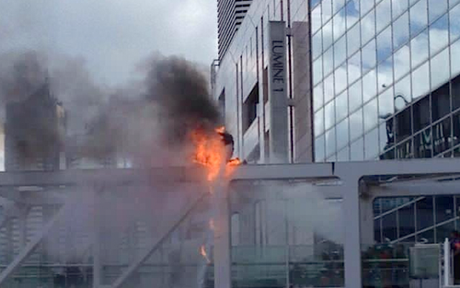
Typhoon Haiyan, worst and deadliest typhoon in Philippines history
by Sasha / Earth First! Newswire
Climate change is a war waged against the people of the Global South by industrial powers. A historical epoch is descending, and the islands of the Pacific are drowning. Waters will rise three feet over the next 90 years in Micronesia, a devastating potential for those 607 islands. The small island of Kiribati is already evacuating; the UK purchased a swath of land in Fiji as a climate refugee camp for the fleeing, but Fiji, itself, is looking into the eye of climate change enhanced storms and droughts.
The pressure on Southeast Asian populations is also mounting. Among the strongest typhoons ever recorded, Typoon Haiyan left more than 6,000 dead in the Philippines alone. Aid plans are still the works, some eight months after the most deadly storm in that nation’s history. Two years after the Tōhoku earthquake triggered a tsunami that hit Fukushima Daiichi, a once-in-a-decade typhoon slammed into the country, killing 17 and causing more nuclear contamination. The condition of climate refugees is only going to put greater pressure on diplomatic relations in the region, as even the US Department of Defense has stated that its infrastructure is vulnerable to climate change in the region.
Far from promoting a way to escape climate change, the North Atlantic aims to extract fossil fuels from the contested energy-rich waters of the South China Sea by whatever means available. As the US turns its “pivot to Asia,” however, it is mirrored by Russia. Where the US uses the Association of South East Asian Nations (ASEAN) to chip away at China’s hegemony in the region, Russia works closely with China. The two countries recently signed a gas infrastructure deal that develops a historic partnership. Rosneft just deployed the world’s largest offshore oil drilling platform off Sakhalin Island while mending ties to Japan after the Crimea polarizations, and China has pushed a second offshore oilrig into waters contested by Vietnam. A storm is brewing larger than a typhoon.
Dollars and Gunboats
Dozens of Vietnamese police vessels attempting to pursue the rigs have been rammed by Chinese ships. Vietnam has called on its allies in the Philippines for protection, and the US has reinforced its military partnership with the Philippines in response. Vietnam and the Philippines joined together for war games in the contested Spratly Islands, where China is building a controversial airstrip. In support of the Philippines and Vietnam, Japan altered its constitution to allow the ability to launch a military attack in defense of its allies.
Amidst war games in Southeast Asia, Chinese fighters have been tailgating and buzzing Japanese reconnaissance planes. In early June, a Russian fighter jet intercepted a US recon plane over the Sea of Okhotsk, off Sakhalin Island. North Korea’s recent launching of missiles has angered Japan, setting the region further on edge. Thailand’s military junta plays the wildcard.
The “Eastern Tigers” clique that seized power once again from the China-friendly Shinawatra regime has deep ties to US counterinsurgency, but also seems to play up to its role as the representative of ASEAN to China. Moody’s “Inside Asia” report warns that Thailand is especially vulnerable to China’s economic slowdown, gesturing towards the potential benefits of the US-driven Trans Pacific Partnership (TPP). However, the TPP seems to be crumbling, as Vietnam, supported by Malaysia and several other countries, protests US protections over domestic catfish production. Japan has shown signs of ducking out of the TPP as well, bartering with Australia for closer bilateral ties instead of a larger area agreement.
Not that China has had much luck on the other end. Taiwan’s tremendous Sunflower Movement emerged last year as a direct result of China’s attempts to pull the Kuomintang government of Thailand closer into its orbit through a bilateral trade pact. The resulting protests involved tens of thousands of people in the streets and the cancellation of the agreement. China’s territorial claims over Taiwan include the Senako Islands, which Japan also claims, and China’s Taiwan Affairs Office director, Zhang Zhijun visited last week in a historic show of polity. Although Zhang used the local dialect and came with offerings of peace, his presence was protested throughout the area. At one point, protesters splashed the dignitary with white paint, causing the cancellation of two events.

Zhang being splattered with pant (Reuters)
Axis of Discontent
Beijing’s desires in the South China Sea are dampened by internal strife. In particular, the pro-democracy movement of Hong Kong has shaken the country, bringing somewhere between 100,000 to 500,000 demonstrators into the streets on July 1 to call for regional autonomy. As one of the most essential strategic trading areas in the world, Hong Kong is virtually the face of China in the region. But it is not just China that is seeing mounting protests.
There are also ongoing protests against militarization and bad governance in Japan and the Philippines. In the former country, 40,000 demonstrators gathered outside of the Prime Minister’s house in late June after a man calmly set himself on fire in a busy rail station in Tokyo to protest against Japan’s move to lift prohibitions against military engagement. Japan is at a turning point.
At the same time, in the Phillipines, more than a thousand farmers stormed the Department of Agricultural Reform’s offices, blockading themselves inside and demanding sensible policies. President Aquino has been called out for extensive corruption, and impeachment hearings may be incoming. Among other ills, the government of the Philippines has engaged in bombing and infantry campaigns against Indigenous peoples under the pretext of combatting the New Peoples Army. Danilo Reyes, head of the Asia Human Rights Commission’s Philippines Desk, explains, “[T]he Philippines’ security forces have succeeded in creating perceptions that [legitimate demands for land, food, and protection of rights] are ‘security risks,’ so they could justify killings, arrests, detention and disappearance of human rights and political activists.”
The diplomatic crisis of the Pacific indicates that the conditions of the Global Land Grab are solidifying into resource wars between hegemonic blocs of NATO and Russia-China. As the US financial doyens brace themselves for, gasp, reports of a “successful” market, and food prices continue their three-month decrease around the world, many territorial struggles are taking on a new character—from dispersed, corporate-driven land struggles to focused diplomatic disputes with clear nationalist character.
This new Cold War was highlighted by South Korean Defense Minister Kim Kwang-jin, who attached this hallmark statement to the gift of a warship sent to the Philippines: “South Korea’s gesture is a small token compared with the great contribution of Filipino troops during the Korean War.” At the same time, China continues to express consternation over Japan’s militarization after Shinzo Abe’s visit to the shrine of Japanese war criminals from WWII. The plethora of references to the Cold War, alluded to by all sides, reveals horrific possibilities of mounting stakes of extremism in the South China Sea.

Japanese man commits self-emmolation to protest militarization
Alexander Reid Ross is co-moderator of the Earth First! Newswire and editor of Grabbing Back: Essays Against the Global Land Grab (AK Press 2014). His work can also be found in Life During Wartime: Resistance Against Counterinsurgency (AK Press 2013).

